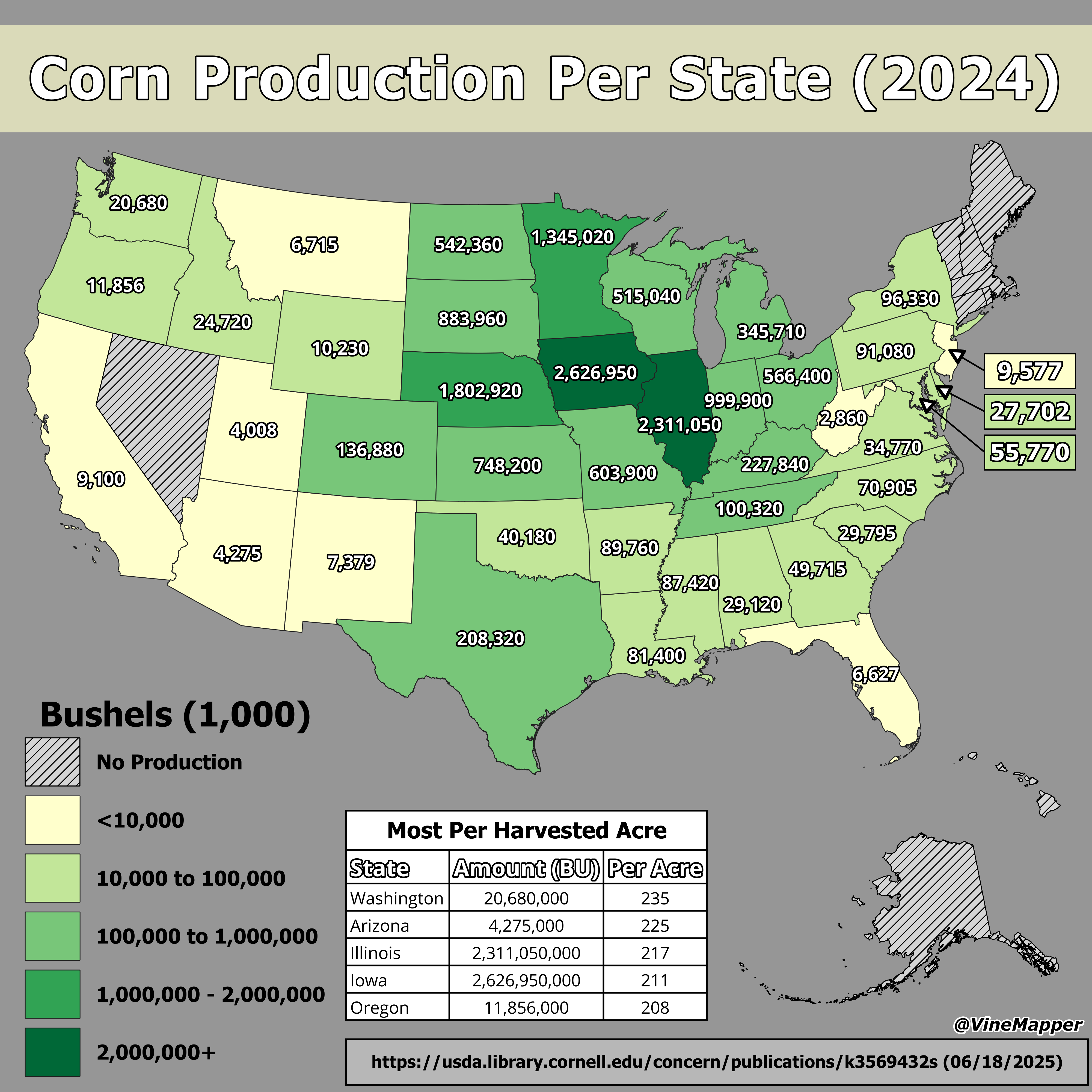Corn Production Per State Map


Alex Cartwright
Senior Cartographer & GIS Specialist
Alex Cartwright is a renowned cartographer and geographic information systems specialist with over 15 years of experience in spatial analysis and data...
Geographic Analysis
What This Map Shows
This map illustrates the corn production levels across the United States, highlighting which states lead the nation in this critical agricultural commodity. Corn, often referred to as maize in many parts of the world, is a staple crop that plays a significant role in both the economy and the food supply chain. The visualization clearly indicates the varying production levels across different states, showcasing a vivid portrayal of U.S. agriculture and its regional strengths.
Deep Dive into Corn Production
Corn production is a vital component of the American agricultural landscape. In 2022, the United States produced over 15 billion bushels of corn, making it the largest producer in the world. This crop is essential not only for human consumption but also for animal feed, biofuels, and a myriad of industrial products.
Interestingly, corn is grown in every state, but a few states dominate the production landscape. Iowa, for instance, consistently ranks as the top corn-producing state, contributing nearly 20% of the total U.S. corn supply. This is largely due to its fertile soil, favorable climate, and advanced farming techniques that optimize yield. Other leading states include Illinois, Nebraska, and Minnesota, which also benefit from similar agricultural advantages.
What's fascinating is that the climate and soil types in these regions heavily influence the types of corn grown and the overall yield. The Midwest, often referred to as the "Corn Belt," has the ideal conditions for corn farming. The region receives adequate rainfall, has nutrient-rich soil, and experiences a growing season that allows for maximum crop development.
Furthermore, corn serves as a foundational crop for various food industries. Corn syrup, cornmeal, and even high-fructose corn syrup are derived from this versatile crop. Additionally, a significant portion of the corn produced in the U.S. is used for livestock feed, highlighting its role in supporting the meat industry.
However, corn production is not without its challenges. Issues such as climate change, soil degradation, and market fluctuations can impact farmers' decisions and crop yields. The rise of genetically modified organisms (GMOs) has also transformed corn farming, allowing for greater resistance to pests and diseases, but it has sparked debates about food safety and environmental impacts.
Regional Analysis
When we analyze the map, we can see distinct regional clusters of corn production. The Midwest, encompassing states like Iowa, Illinois, Indiana, and Ohio, stands out with its high production levels. For example, Iowa alone produced approximately 2.5 billion bushels in 2022, while Illinois contributed around 2.1 billion bushels.
Moving to the Great Plains, states like Nebraska and South Dakota also play significant roles in corn production. Nebraska's production is bolstered by its rich loamy soils and ample water resources, primarily from the Ogallala Aquifer. Interestingly, the production levels fall drastically as we move westward, where conditions become less favorable for large-scale corn farming due to drier climates and shorter growing seasons.
On the contrary, states in the Southeast, such as Florida and Georgia, produce considerably less corn. Here, the agricultural focus often shifts towards crops like peanuts and soybeans, which are more suited to the climatic conditions. Even in regions like California, where agriculture thrives, corn production is minimal compared to other crops such as almonds and lettuce.
Significance and Impact
Understanding corn production's geographical landscape is crucial for several reasons. First, corn is not just a crop; it's a cornerstone of the U.S. economy, impacting everything from food prices to biofuel production. As the global demand for corn continues to rise, especially in developing nations, the implications for U.S. farmers and the agricultural sector are vast.
Moreover, fluctuations in corn production can significantly affect food supply chains and commodity markets. For instance, a drought or unfavorable weather could lead to reduced yields, driving up prices not only for corn but also for products derived from it. This ripple effect can impact consumers and industries alike.
Looking ahead, current trends suggest that advancements in agricultural technology, sustainable practices, and climate resilience strategies will shape the future of corn production. Farmers are increasingly adopting precision agriculture techniques, utilizing data and technology to maximize their yields while minimizing environmental impacts. As we consider the future, it’s essential to monitor how these factors will influence corn production and, by extension, the broader agricultural landscape in the United States.
In summary, the "Corn Production Per State Map" serves as a vital tool for understanding the distribution and significance of corn farming in the U.S. By examining the data, we can appreciate the complexities of agricultural production and its critical role in sustaining both local and global economies.
Visualization Details
- Published
- August 14, 2025
- Views
- 96
Comments
Loading comments...